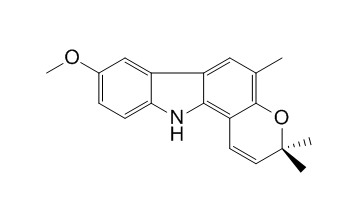Koenimbine
Koenimbine can induce DNA damage and heat shock protein modulation in HepG2 cells.
Inquire / Order:
manager@chemfaces.com
Technical Inquiries:
service@chemfaces.com
Tel:
+86-27-84237783
Fax:
+86-27-84254680
Address:
1 Building, No. 83, CheCheng Rd., Wuhan Economic and Technological Development Zone, Wuhan, Hubei 430056, PRC
Providing storage is as stated on the product vial and the vial is kept tightly sealed, the product can be stored for up to
24 months(2-8C).
Wherever possible, you should prepare and use solutions on the same day. However, if you need to make up stock solutions in advance, we recommend that you store the solution as aliquots in tightly sealed vials at -20C. Generally, these will be useable for up to two weeks. Before use, and prior to opening the vial we recommend that you allow your product to equilibrate to room temperature for at least 1 hour.
Need more advice on solubility, usage and handling? Please email to: service@chemfaces.com
The packaging of the product may have turned upside down during transportation, resulting in the natural compounds adhering to the neck or cap of the vial. take the vial out of its packaging and gently shake to let the compounds fall to the bottom of the vial. for liquid products, centrifuge at 200-500 RPM to gather the liquid at the bottom of the vial. try to avoid loss or contamination during handling.
Agriculture2024, 14(12), 2301
Chin J Pharm Anal.2019, 39(7):1217-1228
Plants (Basel).2023, 12(1):163.
Front Plant Sci.2024, 15:1458916.
J Physiol Biochem.2024, 80(2):421-437.
Horticulturae2022, 8(10), 975.
Molecules.2021, 26(13):4081.
Korean J. Food Preserv.2023, 30(4):663-668.
Food Structure2023, 36:100324.
Biomed Pharmacother.2021, 137:111362.
Related and Featured Products
Natural product communications, 2014, 10(2).
QuantitativeAnalysis of BioactiveCarbazole Alkaloids in Murraya koenigii(L.) Spreng.[Reference:
WebLink]
Carbazole alkaloids induce apoptosis in HL-60 cells through activation of the caspase-9/caspase-3 pathway and they are targeted as potential anticancer agents. Thus, the naturally occurring carbazole alkaloids become important as precursors for lead optimization in drug development.
METHODS AND RESULTS:
A method based on ultra performance liquid chromatography coupled with photodiode-array detection was developed using reverse phase isocratic elution with 85:15 acetonitrile and ammonium acetate buffer (5 mM). Seven samples of Murrya koenigii (L.) Spreng. from north-central India (Uttar Pradesh) were analyzed. All three targeted analytes, koenimbidine (mk1), Koenimbine (mk2) and mahanimbine (mk3), were well separated within 4.0 min with linearity of the calibration curves (r2 > 0.999). The limits of detection and quantification of mk1, mk2 and mk3 were 0.7, 0.4, 0.04 μg/mL and 2.14, 1.21, 0.12 μg/mL, respectively. The natural abundance of mk1, mk2 and mk3 was 0.06-0.20, 0.04-0.69 and 0.13-0.42%, w/w, respectively, in the dried powdered leaves, whereas, the tissue specific distribution of carbazole alkaloids was observed in the order of predominance, mk1 leaf>root>fruit>stem, mk2 fruit>leaf >stem>root, and mk3 fruit>leaf>root>stem. The developed method was validated for limits of detection and quantification, repeatability, accuracy, precision and stability.
CONCLUSIONS:
This is the first report on the natural abundance of the major carbazole alkaloids in M. koenigii and the method developed can be used in HPLC/UPLC systems.



